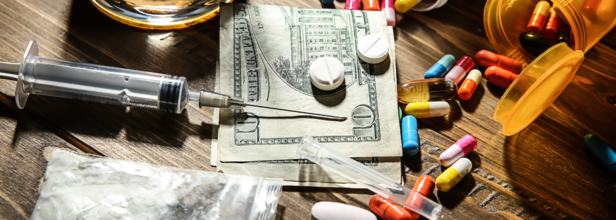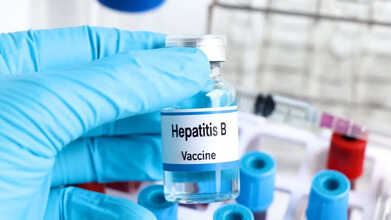- Health Conditions A-Z
- Health & Wellness
- Nutrition
- Fitness
- Health News
- Ayurveda
- Videos
- Medicine A-Z
- Parenting
What Are The Most Abused Drugs In The US?

Credits: Canva
Drug abuse is a serious problem, which is capable of not only causing death to the one using it, but create a havoc in the lives of those who are associated with that person too. There have been plenty cases, whether it is Matthew Perry or the recent death of Liam Payne, which is in trial currently.
It is also a problem in the US and is emerging as one of the health concerns that could destroy families and society. One of the most alarming aspects of drug abuse is also its impact on public safety as well as increased crime rates. Drugs also take a heavy toll on healthcare systems as emergency departments frequently encounter cases of drug overdoses, which puts the burden on medical professional who have the strain the limited resources available.
There are also long-term health impact due to drug abuse, which includes organ damage, infectious disease, mental health disorders and rise in healthcare cost.
Are there any specific drugs which are most abused in US?
Yes. There are commonly used drugs, which also includes prescribed painkillers like oxycodone, hydrocodone, and fentanyl, as well as illicit substances like heroin. As per recent data, opioid abuse has also reached alarming levels which has affected millions of Americans.
Here are the most abused drugs in the US:
Stimulants
They are used to increase alertness, attention, and energy. They also have a high potential for abuse due to the euphoric and performance enhancing effects. Cocaine and methamphetamine are notable stimulants frequently abused in the US. As per 2019 data, 10.3 million people reported to misuse stimulants in the previous year.
Depressants
These substances are used to slow down brain activity and induce relaxation. Benzodiazepines is one of the commonly prescribed medicine. Around 4.8 million individuals in the US have misused this drug.
Other misused drugs and its affects on the health:
Opioids:
It could lead to slow breathing and heart rate. It can also increase the risk of overdose and respiratory failure, constipation and a weakened immune system.
Stimulants:
It can elevate heart rate and blood pressure. It could also increase body temperate and lead to an irregular heartbeat. Furthermore, one can experience loss of appetite and weight loss.
Cannabis:
This can alter perception and coordination. People who consume it often have red eyes and a dry mouth. This can increase appetite, sometimes the "munchies" can reach to a point of no return and it could impair memory and cognitive function.
Benzodiazepines:
It could lead to sedation and drowsiness and an impaired coordination and balance. There also could be memory problems and confusion, along with respiratory depression, when combined with other depressant substance.
Alcohol:
This could lead to slurred speech, impaired condition, poor judgment and decision-making, liver damage and cirrhosis and an increased risk of accidents and injuries, which is the 3rd most leading cause of death in the US.
Additional Negative Impact: Social and psychological
Substance abuse impairs job performance and reliability, leading to frequent absenteeism, reduced productivity, and even job loss. This further leads to financial instability, strained relationships, and a cycle of dependency.
Flu Cases In The UK Are Rising Fast This Year—Here’s What Is Making It Worse

Credits: Canva
NHS Flu Cases: Flu season has arrived far earlier than expected this year, and hospitals across England are already seeing a sharp rise in cases. The latest figures show that the number of patients admitted with flu is more than 50 percent higher than the same week last year. During the week starting 24 November, an average of 1,717 people were in hospital with flu each day, including 69 who needed critical care, as per The Independent.
In the same week last year, the total was 1,098 patients, with 39 in critical care. These numbers follow recent warnings from the NHS, which urged vulnerable groups to get their flu jabs as early as possible, as experts fear this could turn into one of the most challenging winters in recent memory. This raises several key questions. What is driving this sudden surge, how severe could the coming months be, and how much protection can the vaccine offer?
NHS Flu Cases: What’s Causing The Flu Surge?
Specialists suspect an altered form of influenza A is behind the early rise in cases. They observed Australia’s recent flu season, which often gives a hint of what lies ahead for the UK, and saw record-breaking infection levels. Alerts also came from the Asia-Pacific region, where Japan announced a flu epidemic in October and schools were temporarily closed.
Flu viruses fall into three groups: influenza A (H1N1), influenza A (H3N2), and influenza B. This year, the main culprit is the H3N2 strain. Flu viruses constantly change through a process called antigenic drift, which is why vaccines are updated each year. In the Northern Hemisphere, the strains for the upcoming winter season are chosen in February.
However, this particular H3N2 strain, known as subclade K, changed more rapidly over the summer and is now considered significantly different from the strain used in the current vaccine, according to the UK Health Security Agency (UKHSA). After reviewing the latest NHS numbers, Sarah Woolnough, chief executive of The King’s Fund, noted that the flu season has “not yet peaked,” adding that it is still uncertain how long this early surge will last.
NHS Flu Cases: How Bad Is It?
Health experts fear that thousands of people could lose their lives this winter. Flu-related deaths more than doubled last year, with the UKHSA estimating 7,757 deaths in England, compared with 3,555 the year before. Deaths among children also rose from 34 to 53. Senior NHS leaders have warned of a very difficult winter ahead. In November, NHS England chief executive Jim Mackey said staff may face “one of the toughest” seasons yet.
He admitted that the prospect of a long, heavy flu season had been a major concern, and current trends suggest that these worries were well founded. Australia recorded its worst flu season on record, with more than 410,000 cases, and the expectation is that the UK may face similar patterns. He added that from December through March, hospitals will likely run at full capacity.
NHS Flu Cases: How Effective Are The Vaccines?
The UKHSA has analysed how well this year’s vaccine is performing by examining whether vaccinated people are less likely to be admitted to hospital with flu. Early assessments show that the vaccine is offering around 70 to 75 percent protection against hospital attendance in children aged two to seventeen, and around 30 to 40 percent protection in adults.
Dr Jamie Lopez Bernal, consultant epidemiologist for immunisation at UKHSA, said he remains confident that the vaccine will provide important protection for those most at risk, regardless of which strain becomes dominant. He explained that practising good respiratory hygiene and reducing contact with others when symptomatic can also help lower transmission. According to NHS England, 14.4 million flu vaccines were administered during the autumn, which is more than 160,000 ahead of the same point last year.
NHS Flu Cases: Should You Get A Flu Vaccine?
Flu vaccinations are free and advised for several groups, including:
- Everyone aged 65 and above
- People under 65 who fall into clinical risk categories
- Residents of care homes and their carers
- Pregnant women
- Close contacts of people who are immunosuppressed
- Frontline health and social care workers
- Children
Vaccinations began in October, but anyone eligible can still get their jab until 31 March.
You can get vaccinated by:
- Making an appointment with your GP surgery
- Booking a free NHS flu jab at a pharmacy through the NHS website or app
- Visiting a pharmacy that offers walk-in NHS flu vaccinations if you are 18 or older
As of 23 November, 69.6 percent of people aged over 65 had received their jab. Uptake was lower in other groups, including adults under 65 with long-term health conditions (35.1 percent), pregnant women (33.9 percent), and children aged two (39.8 percent) and three (40.3 percent).
Hepatitis B Infection And Vaccination: Risks, Safety, And Long-Term Protection

Credits: Canva
A federal vaccine advisory group in the United States is preparing to decide whether newborns should continue to receive the hepatitis B vaccine, which was the first shot proven to prevent cancer. The CDC committee is expected to revisit the long-standing guidance from the early 1990s, when the vaccine began to be given within the first 24 hours of life.
As per CNN, advisers to the Centers for Disease Control and Prevention will be voting on Friday to vote on whether the agency should move away from its long-held recommendation that every infant receive the hepatitis B shot shortly after birth. The information below outlines key points everyone should understand about hepatitis B and its vaccine.
What is Hepatitis B?
Hepatitis B is a viral infection that affects the liver. Many adults are able to clear the virus after an acute infection. Some, however, go on to develop chronic hepatitis B, which increases the risk of liver cancer, liver failure and cirrhosis, or permanent scarring of the liver.
People who live with chronic hepatitis B face a much higher chance of dying early. At the ACIP meeting on Thursday, Dr. Sandra Fryhofer, who spoke on behalf of the American Medical Association, described her experience working on a hepatitis B ward during medical school, according to CNN.
She said that those were the sickest patients she had ever encountered. She explained that she has treated people with liver disease caused by hepatitis B, cirrhosis linked to the virus, and liver cancer, as well as deaths related to the infection. Infants and young children who contract hepatitis B are far more likely to develop lifelong disease, including about 90 percent of infected babies and roughly 30 percent of children between one and five years of age.
How Is Hepatitis B Spread?
The hepatitis B virus is highly contagious. It spreads when blood, semen or other bodily fluids from a person who carries the virus enter the body of someone who is not infected.
Certain medical conditions, personal habits and other circumstances can raise the risk, such as injection drug use or sexual contact, but the virus can infect anyone. Hepatitis B can also pass from an infected mother to her baby during childbirth, whether through a vaginal delivery or a C section.
How Common Is Hepatitis B?
Many people living with hepatitis B show no clear symptoms, and more than half may not know they are infected. Recent CDC figures report about 2200 newly documented cases of acute hepatitis B in 2023, although the true number is estimated to be more than six times higher, closer to 14400.
The CDC also estimates that about 640000 adults in the United States have chronic hepatitis B. Worldwide, the World Health Organization reports that 254 million people are living with chronic hepatitis B, with about 1.2 million new infections each year.
Can Hepatitis B Be Treated?
There is no treatment for acute hepatitis B. Some medicines are available for chronic infection. These treatments may need to be taken for life because there is no cure.
How Can Hepatitis B Be Prevented?
Vaccination is the most reliable way to prevent hepatitis B. The shots offer strong protection in infancy and continue to shield individuals well into adulthood.
Most people who live with hepatitis B contracted it as babies or very young children, when their immune systems were not fully developed, according to the CDC. At present, the agency recommends that all infants receive the vaccine at birth before leaving the hospital.
Babies usually receive a three dose series. A scientific review by the Vaccine Integrity Project found that 95 percent of healthy infants develop enough immunity after the third dose. The vaccine also lowers the risk of infection by nearly 70 percent in babies born to mothers who have hepatitis B.
More than 90 per cent of people who completed the vaccine series showed signs of continued protection 30 years later, based on CDC data.
Is The Hepatitis B Vaccine Safe?
According to the Vaccine Integrity Project’s review, giving the hepatitis B shot at birth has consistently proven safe. Only mild and short-lasting reactions have been noted, such as slight swelling or redness at the injection site and low fever. There was no rise in serious life-threatening reactions linked to the vaccine.
Dr. Anthony Fiore, an infectious diseases specialist and former CDC official who worked in the hepatitis division, described it as a very safe vaccine. He said it has been studied thoroughly before and after approval. He added that the United States vaccine safety systems have looked closely at concerns about fever or other chronic problems.
He explained that none of these concerns have been confirmed. No long-term harm has been linked to the vaccine, and nothing comes close to the danger posed by chronic hepatitis B infection.
How You Drive Could Tell You About Your Cognitive Decline

Credits: iStock
Most of us do not think twice about our daily driving habits. We take the same turns, choose the same roads, and travel at roughly the same times every day. But according to new research from Washington University in St Louis, these small choices may quietly reflect something deeper happening inside the brain. The findings are published in the journal Neurology.
The study suggests that subtle changes in driving behavior could serve as early warning signs of cognitive decline. In other words, the way an older adult drives today may help predict future memory or thinking problems long before they become obvious.
What the Researchers Found
The team focused on people already diagnosed with mild cognitive impairment, often considered a transitional stage between normal aging and conditions like Alzheimer’s disease. They analyzed data from 56 individuals with mild cognitive impairment and compared it with information from 242 adults of similar age who showed no cognitive issues. The average age in both groups was 75.
Instead of relying only on memory tests or conversations with patients, the researchers added GPS tracking data collected directly from participants' vehicles. This allowed them to understand how often people drove, where they went, what routes they chose, and how they behaved behind the wheel over a period of nearly three and a half years.
What emerged was a pattern. People with mild cognitive impairment gradually began driving less often and to fewer places. They stuck to familiar routes, avoided more complex trips, and showed less variation in the times they traveled. They also tended to speed less. Even after adjusting for factors like age, education level, and genetic risk of Alzheimer’s, the differences in driving habits remained clear.
Driving Behavior as a Diagnostic Tool
The researchers found that driving data alone correctly identified individuals with mild cognitive impairment 82 percent of the time. When combined with standard cognitive tests and demographic information, accuracy rose to 87 percent.
Neurology researcher Ganesh Babulal explained that early identification of unsafe drivers is a public health priority, but the usual evaluation methods can be slow and difficult. According to him, adding GPS tracking to traditional screening tools could offer a practical and more accurate way to spot early cognitive problems.
He noted that daily driving behavior is a low effort and unobtrusive marker of how well someone is functioning. Since driving requires quick thinking, coordination, and attention, even small cognitive changes can influence how people choose to navigate the road.
What Comes Next
The research team plans to expand the study to include larger and more diverse groups of people. They also hope to bring in additional factors, such as vehicle type, where participants live, and other medical conditions.
Their goal is not to take away anyone’s independence but to help identify risks earlier so that support and interventions can be offered before a crash or near miss occurs. At the same time, the researchers stress that any tools developed from this work must balance safety with respect for personal autonomy and privacy.
This study opens an important conversation: sometimes the first signs of cognitive decline do not show up in a doctor’s clinic. They show up quietly, in the everyday paths we choose and the roads we avoid.,
© 2024 Bennett, Coleman & Company Limited

